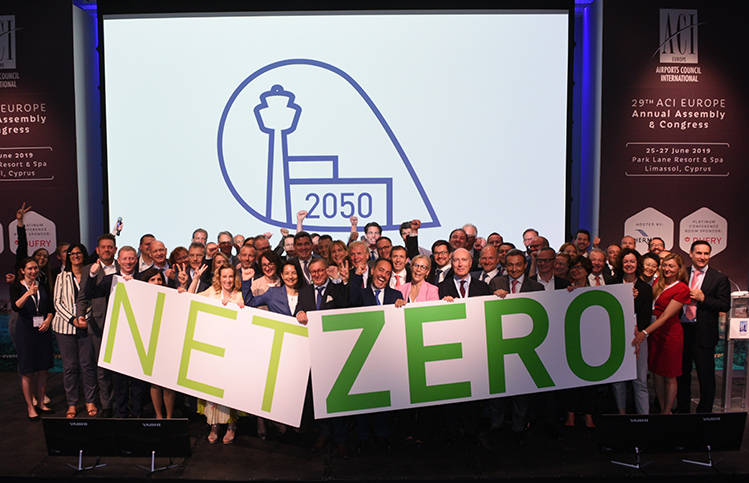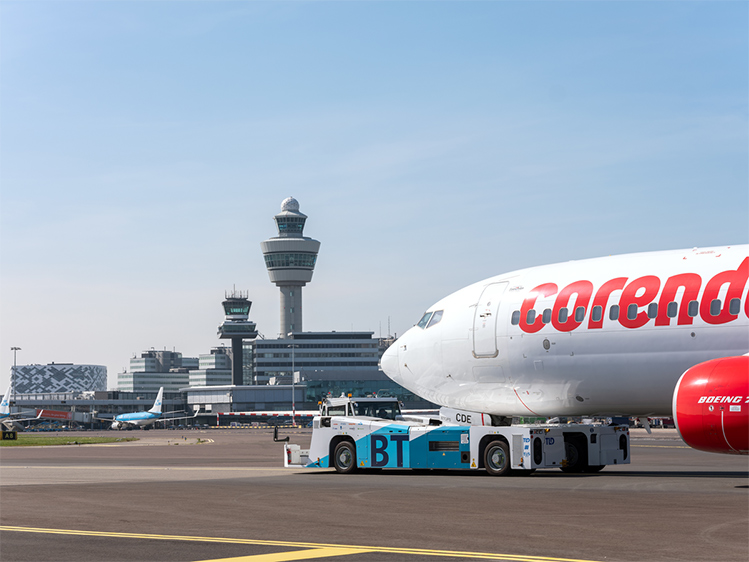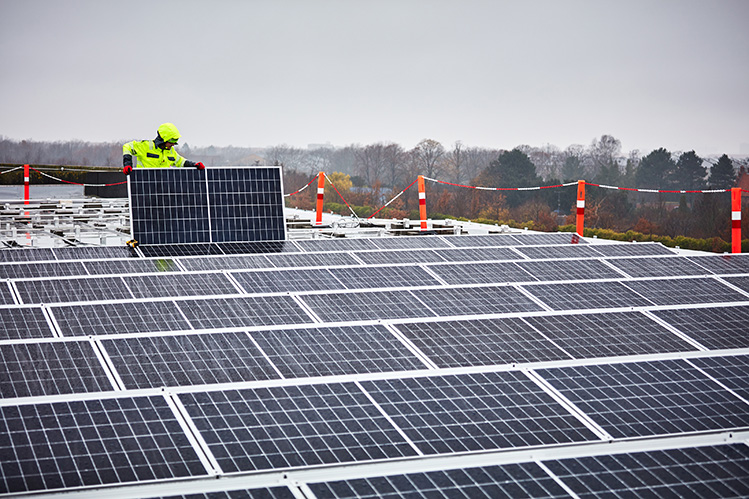An interview with Marina Bylinsky, Head of Sustainability, ACI EUROPE. By Agata Lyznik

Through ACI EUROPE’s Net Zero 2050 commitment from June 2019, European airports aligned their climate ambition with the latest scientific evidence.
There has been a lot of talk about sustainable, balanced, green recovery from the present crisis. Many stakeholders see COVID-19 as an opportunity for a complete reset of our economy. How could this concept play out in the aviation sector?
As we overcome the immediate COVID-19 health emergency, we can indeed take a more forward looking approach and critically assess the way we managed the present crisis, and what we can learn from it for future scenarios. Climate change is going to be a source of new crises and hence remains the greatest long-term challenge we face. As put in a recent study published by the Oxford University and co-authored by the Nobel Prize winner Joseph Stiglitz: “The climate emergency is like the COVID-19 emergency, just in slow motion and much graver.”1
In the context of a sustainable recovery, this study is actually really interesting. It is based on a survey of high-level economic experts, assessing different types of recovery policies. The policy that achieved the lowest score of all referred to aviation bailouts, considering its climate impact but also economic outputs. This conclusion reveals doubts about the long-term economic viability and resilience of the aviation sector. It sends a clear warning signal to the industry, highlighting that the environmental, social and economic dimensions of sustainability are intrinsically linked, and should encourage us to “build back better”.
The good news is that the COVID-19 crisis has delivered very concrete insights that can help us in our sustainable recovery. Firstly, it has shown that we need to trust and follow the science. Goals and strategies can no longer be determined by “what we can achieve” but “what we have to achieve”. For the aviation sector, it means that we need to step up our industry-wide climate goals, and align them with the latest climate science, namely the need to reach Net Zero CO2 emissions by 2050. Secondly, COVID-19 has shown how important early action is to address a looming crisis, and that delays do have a significant human and economic cost. The same is true for climate change. Delaying or reducing the rate at which emission reductions are made today will require more significant cuts in emissions in the future, with higher costs. For the aviation sector, this implies that we have to maintain climate action high on our agenda. Of course, in the current context, we will not be able to deliver on it on our own. This is why public support to the decarbonisation of aviation is more important today than ever. Such support will help our sector regain its economic viability – which is a prerequisite for safeguarding our ability to keep investing in decarbonisation on our own accounts, and ultimately continue providing social and economic benefits to society.
What is the role of airports in this effort?
Through ACI EUROPE’s Net Zero 2050 commitment from June 2019, European airports already aligned their climate ambition with the latest scientific evidence. Of course, for the aviation sector as a whole, the scale of the challenge is different, as we have many more solutions to decarbonise on the ground than in the air. Our role as airports is manifold: we have to first of all reach our own climate goals, but also to support the broader decarbonisation of the air transport system. This refers to facilitating more efficient ground operations, optimised air traffic management but also the provision of infrastructure and associated services for the use of Sustainable Aviation Fuels (SAF), and in the longer run, hydrogen fuelled and electrified aircraft operations. As a matter of fact, as new aircraft technologies emerge on the market, the role of airport operators will be critical to enable their deployment. For instance, if an airline is purchasing an electric airplane, it will only be able to fly it once it can be charged at the airport and benefit from associated maintenance and handling services. The “deeper” we get into the decarbonisation of air transport, the more important the role of airports will be as nodes of climate action, accelerating and removing roadblocks for new technologies and operations, in cooperation with industry partners.
Speaking about a sustainable recovery from an airport perspective, we should also not forget about its more local components, for instance mitigation of noise and air pollution or resources management. In these areas as well, we can use the recovery from COVID-19 as an opportunity to explore new, innovative approaches.

This summer, Amsterdam Airport Schiphol is trialling sustainable aircraft taxiing.
Did airports continue to unroll initiatives aimed at reducing CO2 during the pandemic?
It is great to see that in spite of the COVID-19 crisis, airports have indeed been introducing new environmental initiatives in the past months. For instance, Schiphol Airport launched a trial of Taxibot, an electric tow vehicle that allows aircraft not to burn fuel while taxiing – reducing not only CO2, but also local air pollutant emissions.
Copenhagen Airport partnered with several other Danish companies to develop green hydrogen and synthetic fuels. 10 airports, amongst them 6 in Europe, have entered Airport Carbon Accreditation since 11 March, when the WHO declared COVID-19 a pandemic. In fact it’s actually in this difficult period that the programme hit the milestone of 300 accredited airports worldwide, as we have 309 of them now.
How can ACI EUROPE influence the situation positively? Has there been any adjustment in its position triggered by the crisis?
I see several roles for ACI EUROPE in this situation. Firstly, we have to facilitate the continuity of airport climate action. This involves awareness-raising within the membership, advocacy and practical steps to ensure the supporting tools we provide remain fit-for purpose in a new environment.
Awareness-raising is one of the areas we have worked on under the Off the Ground project, concluding that in addition to being a moral obligation, climate action will be key to rebuild public trust in aviation, achieve operational efficiencies, but also secure access to public and private investment. We also see an increasing number of policy but also investor initiatives to better understand how sustainable different assets are, and direct investments accordingly. In spite of the massive shake up of our industry and the uncertainty about what the landscape will look like one year from now, continued climate action does thus make business sense.
As regards advocacy, ACI EUROPE plays an important role in exploring opportunities for public funding to support airport decarbonisation during the recovery. It is essential that the implementation of the European Green Deal and related national policies are pursued as per initial plan, so as to provide airports and other stakeholders with a stable reference in which to develop their climate action. Furthermore, it is critical to ensure that there is consistency between climate policy and other policy areas. For instance, the process of economic regulation of airports should take into account the need for airports to be permitted and encouraged to make timely investment in decarbonisation.
In terms of supporting tools, we have implemented temporary adjustments to the rules of Airport Carbon Accreditation to help our members maintain their participation in the programme. Amongst others, these changes allow airports to benefit from a one year extension of their certification, a streamlined verification process and thus reduced overall costs of accreditation.
More broadly, we are also going to analyse how far COVID-19 requires us to rethink airport sustainability across its three dimensions. Aviation has proven to be an indispensable connector in the present crisis, ensuring the flow of essential goods, medical equipment and facilitating rescue missions. More than ever aviation’s positive contribution to the regions it serves has come to the fore. We believe this is an opportunity to explore how we can build on this experience to foster our relationship with local communities during the recovery and beyond.

To access clean electricity, airports can either procure it, or generate it on-site. On-site generation is particularly relevant, as it is 100% additional, i.e. creating new green electricity generation capacity and thus substituting conventional electricity. Photo: Københavns Lufthavne A/S
In your opinion, what is the most important measure in addressing emissions from aviation operations?
There is currently no silver-bullet solution to the CO2 emissions from air transport, so a combination of different measures need to be implemented. We usually refer to these as the ICAO “Basket of Measures”, consisting of technology improvements, more efficient operations, SAF and market-based measures, such as the EU Emissions Trading System (ETS) or the ICAO Carbon Offsetting and Reduction Scheme for International Aviation (CORSIA). Various studies are currently being carried out to assess the potential of each of these pillars, and to inform policy-making accordingly. From our perspective, we see that SAF is clearly one of the most significant. The advantage of SAF is that their use does not require changes to existing aircraft engines, nor significant modifications of airport infrastructure. Their operational roll-out can thus be achieved in a much shorter timeframe than, for instance, the entry into service of electric aircraft. The major obstacle to a wide deployment of SAF has so far been a limited production capacity, with a several times higher cost of SAF compared to fossil jet fuel. As such, ACI EUROPE welcomes the decision of the European Commission to develop a dedicated policy framework for SAF through its ReFuelEU Aviation initiative, aiming to scale up production and market uptake of SAF in Europe. We believe that in the context of an economic crisis, this work will be even more important; in addition to decarbonisation benefits, it will also help create jobs.
And what would be the gamechanger for airports in this regard?
Emissions under the airport operator control typically refer to heating and cooling of buildings, ground vehicles and support equipment, on-site processes such as waste processing and most importantly, electricity. The latter on average accounts for roughly 60% of the airport operators’ emissions. From that perspective, access to clean electricity is absolutely key for airport decarbonisation, and is all the more important as it can be used to replace the use of fossil fuel in vehicles or buildings. To access clean electricity, airports can either procure it, or generate it on-site. On-site generation is particularly relevant, as it is 100% additional, i.e. creating new green electricity generation capacity and thus substituting conventional electricity.
Furthermore, from a business resilience perspective, it is also interesting as it helps make an airport operator less vulnerable to disruptions in supply chains which can affect the national electricity grid. Of course, there are also challenges, for instance at the technical level where energy storage needs to be further developed if an airport wishes to produce large volumes of electricity which are not immediately consumed or fed into the grid. We therefore welcome the plans of the European Commission to accelerate the clean energy transition across Europe in the context of a sustainable recovery, as it will be an important enabler for continued airport decarbonisation.







